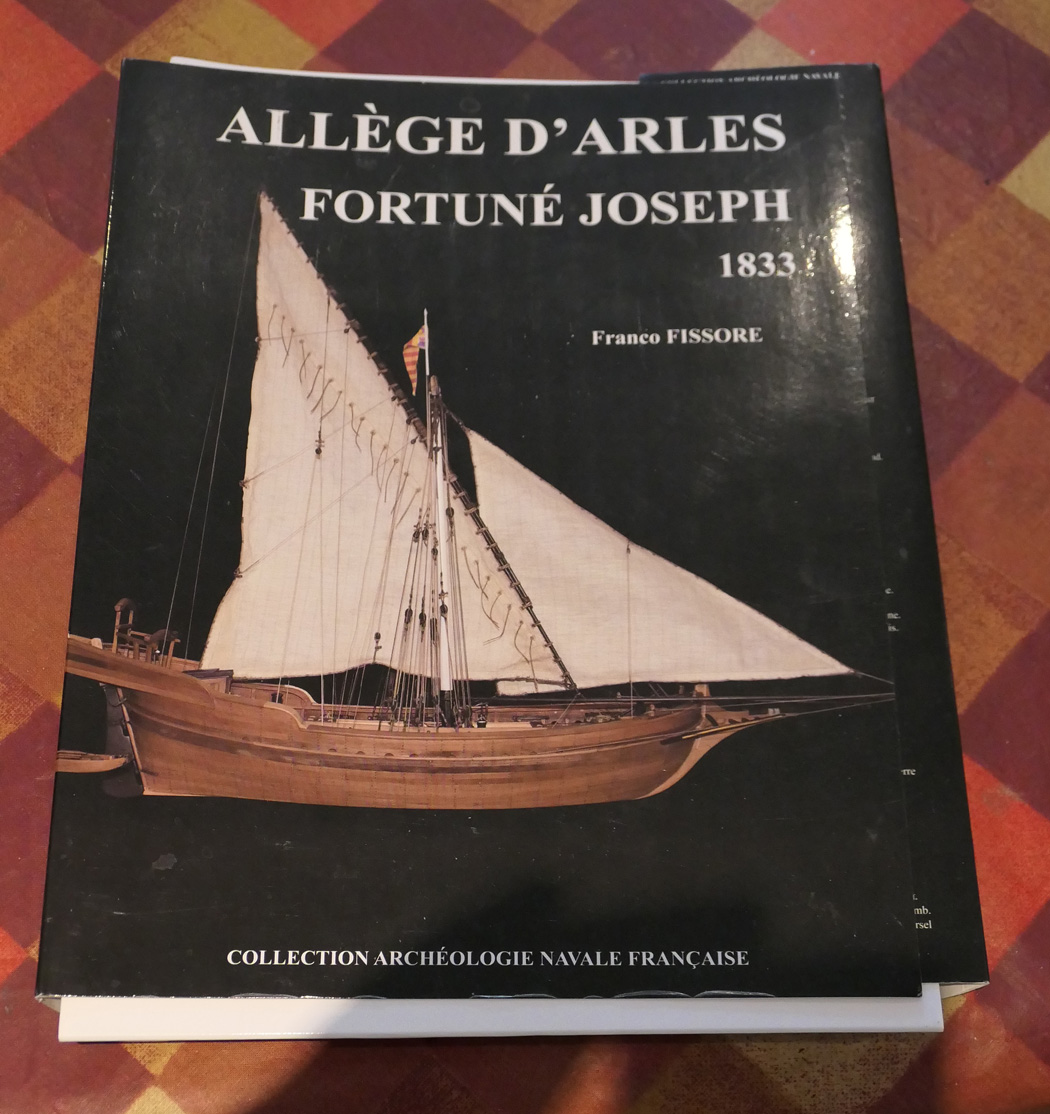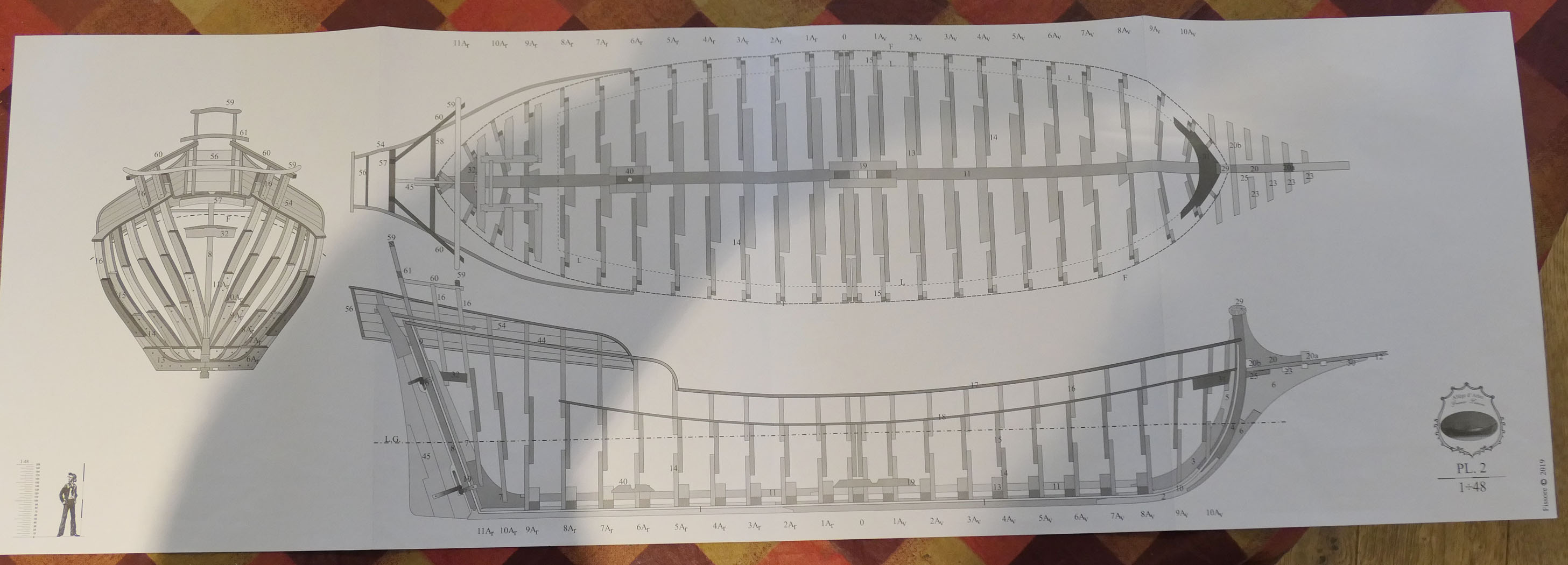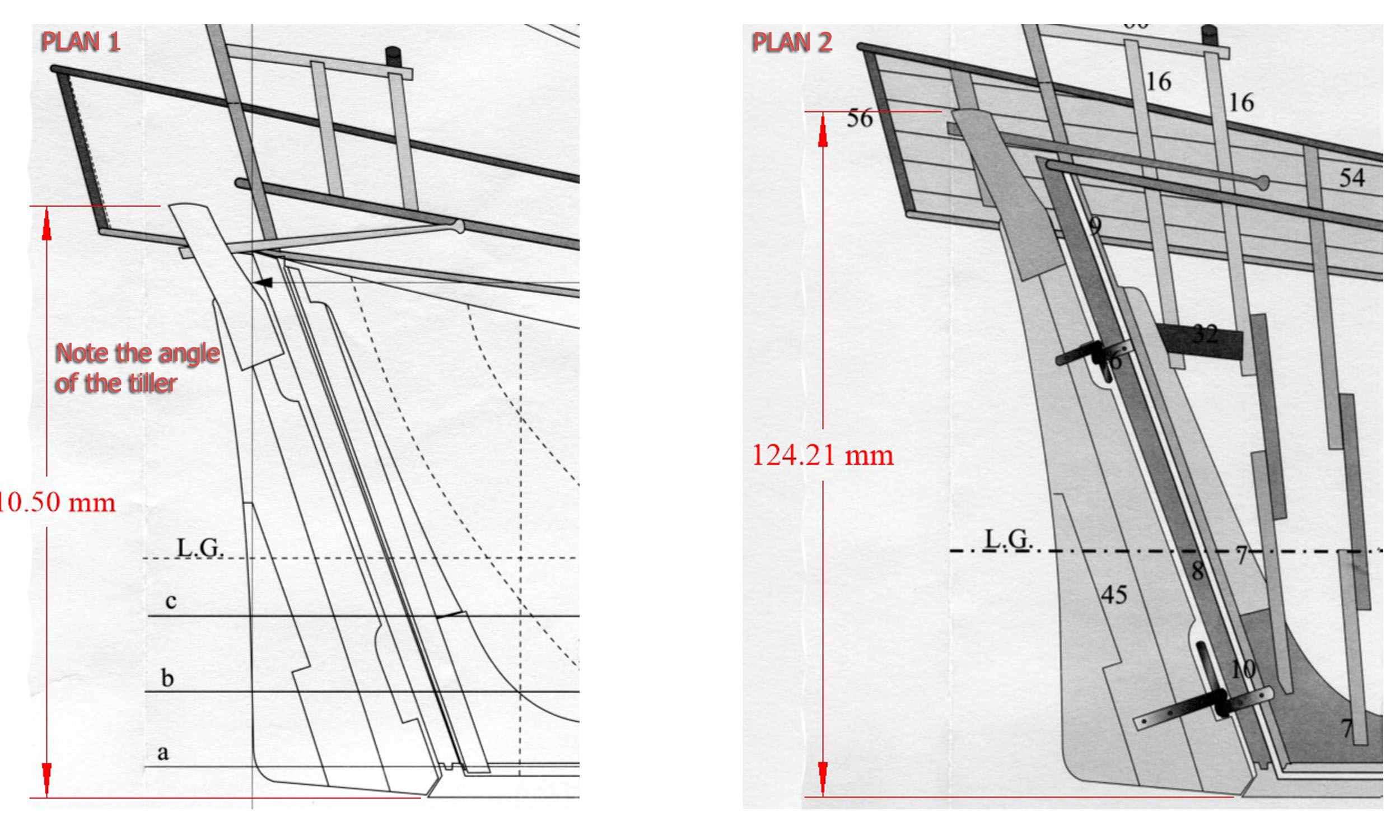03-05-2021, 03:28 PM
I was given the English version of this monograph and, as I like the lateen rig, thought I'd review it and possibly attempt a build of it. The monograph is of the Fortuné Joseph, an allège (or lighter) of 1833 which would have sailed along the Rhône and coastal Mediterranean. There were lots of variation amongst the allèges, this one being the single-masted variety. It carried the colours of the Bouches-du-Rhône at that time.

THE PLANS
Unfortunately, the monograph and plans drawn by F. Fissore of the allège (as others have noted with builds of the Gemma and S.Caterina) do not match the excellence and comprehensive nature of the monographs from other authors published by Ancre such as Jean Boudriot and Gérard Delacroix. Thus this monograph has a very different approach: the usual detailed analysis of the plans in the monograph is instead merely a list of the parts shown in each plan, there are no scantlings provided for any parts or rigging (we are not even given the dimensions of the keel), and the guide to the building of the boat is almost entirely in photographs of the author’s build (most of which are very small, of poor resolution and thus hard to demonstrate detail).
This approach might not be so worrisome to those used to working from plans. It should also be pointed out that the section on rigging is good, especially given the fact that each aspect of the rigging is given its own illustration in the manner of Lennarth Petersson, and this will be discussed later. Another big plus is that the plans are laid out on long pages whose height is that of an A4 page in portrait mode – making it easy to photocopy and then stitch the pages together.
[The dimensions of this photo have been modified to avoid replication.]

However these positive aspects are offset by lots of errors in both monograph and plans which need correction.
My first realisation of problems with the plans came when I compared Plan 1 with Plan 2. They showed the rudder and tiller entirely differently as follows:

In this instance, Ancre immediately responded to my request for clarification and they sent me a pdf of a revised Plan 1 which corrected this anomaly – Plan 2 showing the correct dimensions.
The anomaly made me study the monograph more intensely in case there were further problems which I needed to bring to the attention of Ancre. I soon found lots. There are three main types of problem:
1. The plans are inconsistent with the method of building shown in the photos of the monograph.
There are many details in the photos of the actual build which are not shown in the plans. This led to my having to undo some of the work I had done when I finally spotted the often important detail. One of the many examples is that there are inconsistencies about the number of beams running under the bowsprit fore timbers.
Less importantly, the plans show the frame top timbers extending to the top rails throughout, but the pictures of the build showing the method of construction show the frames ending beneath the lower waterway with the timberheads being constructed separately and fitted into square holes in the waterways and rails. The confusion is worsened by the fact that the plans of the frames themselves do not show the position of the ends of the top timbers at all accurately. Of course, once this is understood, the experienced modeller will be able to adapt their thinking and modify the plans accordingly, but it is at first very confusing when comparing photographs with the plans.
2. The second type of problem is that the plans of the frames are incorrectly drawn, especially in Plan 4 of the frames which shows the floors of each frame extending only to the top of the keel rather than to the top edge of the rabbet. Once this has been spotted by the modeller who has been careful to examine the measurements this again will not be a problem. The base of the floors has simply to be extended by a few millimetres (depending on the scale that will be used).
3. The third type of problem is that of inconsistency between the plans. Thus in some the waterways are shown correctly, and in others they are simply not there. There are many other similar discrepancies.
4. A fourth, more irritating problem, is that the numbers on several of the plans do not match the text of the monograph, nor are they consistent on different pages of the monograph. On some of the plans the numbers are duplicated, with different parts having the same number, on some the parts are given the incorrect names (e.g. a rudder blade is given the same number as a top rail; the keel and the sternpost are both referred to as the sternpost); and some parts are given no reference at all.
Some of these difficulties may possibly be due to the very poor translation into English (some pages are not translated at all from French, which is itself a translation of the original Italian) but obviously the experienced modeller will be able to manage once aware of the difficulties.
All of these are a great pity as excellent models of the Gemma and S.Caterina (both plans of Fissore) have been built (although they do mention but do not detail the difficulties they faced with the plans), and the ships themselves have great attraction. M.Fissore himself shows photos of the builds of his various models including his own of the allège ((http://www.modarsenaval.com/all%C3%A8ge_..._parte.php) at Archeologia e Modellismo d'Arsenal) and it is well worth the visit as the photos there are far, far clearer than in the book). I have written a fairly detailed list of these various problems and submitted them to Ancre for consideration by M. Fissore, so it may be that future editions of these plans and monograph will be made more amenable for a wider range of modellers.
A very similar boat, La Diligente, which was a lateen Navy messenger boat of the 1750s, whose monograph is published by Ancre and written by Gérard Delacroix & Hubert Berti, has the same level of complexity but is not only incredibly detailed and thorough together with complete scantlings: it also provides a set of plans that will allow the less experienced modeller to make it POB rather than POF.
In the interim, as long as one is aware of the problems with plans and monograph, the experienced modeller will be able to use the correct body, sheer and breadth plans on a corrected Plan 1 as the basis for their model.
Tony
THE PLANS
Unfortunately, the monograph and plans drawn by F. Fissore of the allège (as others have noted with builds of the Gemma and S.Caterina) do not match the excellence and comprehensive nature of the monographs from other authors published by Ancre such as Jean Boudriot and Gérard Delacroix. Thus this monograph has a very different approach: the usual detailed analysis of the plans in the monograph is instead merely a list of the parts shown in each plan, there are no scantlings provided for any parts or rigging (we are not even given the dimensions of the keel), and the guide to the building of the boat is almost entirely in photographs of the author’s build (most of which are very small, of poor resolution and thus hard to demonstrate detail).
This approach might not be so worrisome to those used to working from plans. It should also be pointed out that the section on rigging is good, especially given the fact that each aspect of the rigging is given its own illustration in the manner of Lennarth Petersson, and this will be discussed later. Another big plus is that the plans are laid out on long pages whose height is that of an A4 page in portrait mode – making it easy to photocopy and then stitch the pages together.
[The dimensions of this photo have been modified to avoid replication.]
However these positive aspects are offset by lots of errors in both monograph and plans which need correction.
My first realisation of problems with the plans came when I compared Plan 1 with Plan 2. They showed the rudder and tiller entirely differently as follows:
In this instance, Ancre immediately responded to my request for clarification and they sent me a pdf of a revised Plan 1 which corrected this anomaly – Plan 2 showing the correct dimensions.
The anomaly made me study the monograph more intensely in case there were further problems which I needed to bring to the attention of Ancre. I soon found lots. There are three main types of problem:
1. The plans are inconsistent with the method of building shown in the photos of the monograph.
There are many details in the photos of the actual build which are not shown in the plans. This led to my having to undo some of the work I had done when I finally spotted the often important detail. One of the many examples is that there are inconsistencies about the number of beams running under the bowsprit fore timbers.
Less importantly, the plans show the frame top timbers extending to the top rails throughout, but the pictures of the build showing the method of construction show the frames ending beneath the lower waterway with the timberheads being constructed separately and fitted into square holes in the waterways and rails. The confusion is worsened by the fact that the plans of the frames themselves do not show the position of the ends of the top timbers at all accurately. Of course, once this is understood, the experienced modeller will be able to adapt their thinking and modify the plans accordingly, but it is at first very confusing when comparing photographs with the plans.
2. The second type of problem is that the plans of the frames are incorrectly drawn, especially in Plan 4 of the frames which shows the floors of each frame extending only to the top of the keel rather than to the top edge of the rabbet. Once this has been spotted by the modeller who has been careful to examine the measurements this again will not be a problem. The base of the floors has simply to be extended by a few millimetres (depending on the scale that will be used).
3. The third type of problem is that of inconsistency between the plans. Thus in some the waterways are shown correctly, and in others they are simply not there. There are many other similar discrepancies.
4. A fourth, more irritating problem, is that the numbers on several of the plans do not match the text of the monograph, nor are they consistent on different pages of the monograph. On some of the plans the numbers are duplicated, with different parts having the same number, on some the parts are given the incorrect names (e.g. a rudder blade is given the same number as a top rail; the keel and the sternpost are both referred to as the sternpost); and some parts are given no reference at all.
Some of these difficulties may possibly be due to the very poor translation into English (some pages are not translated at all from French, which is itself a translation of the original Italian) but obviously the experienced modeller will be able to manage once aware of the difficulties.
All of these are a great pity as excellent models of the Gemma and S.Caterina (both plans of Fissore) have been built (although they do mention but do not detail the difficulties they faced with the plans), and the ships themselves have great attraction. M.Fissore himself shows photos of the builds of his various models including his own of the allège ((http://www.modarsenaval.com/all%C3%A8ge_..._parte.php) at Archeologia e Modellismo d'Arsenal) and it is well worth the visit as the photos there are far, far clearer than in the book). I have written a fairly detailed list of these various problems and submitted them to Ancre for consideration by M. Fissore, so it may be that future editions of these plans and monograph will be made more amenable for a wider range of modellers.
A very similar boat, La Diligente, which was a lateen Navy messenger boat of the 1750s, whose monograph is published by Ancre and written by Gérard Delacroix & Hubert Berti, has the same level of complexity but is not only incredibly detailed and thorough together with complete scantlings: it also provides a set of plans that will allow the less experienced modeller to make it POB rather than POF.
In the interim, as long as one is aware of the problems with plans and monograph, the experienced modeller will be able to use the correct body, sheer and breadth plans on a corrected Plan 1 as the basis for their model.
Tony



![[-]](https://forum.dubz-modelling-world.com/images/simplicity/collapse.png)
